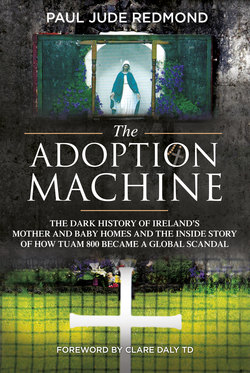Читать книгу The Adoption Machine - Paul Jude Redmond - Страница 8
На сайте Литреса книга снята с продажи.
ОглавлениеForeword
As Ireland gears up for yet another national debate about women’s reproductive rights with the 8th Amendment referendum, Paul Redmond’s The Adoption Machine is a timely reminder of how women and girls who ‘got into trouble’ were dealt with in the early years of the new state, up to the end of the last century.
This book is a personal story and a crusade, one of the first and clearest accounts of conditions in the misnamed Mother and Baby Homes, a cruel mix of Victorian and Catholic morality, institutions which he describes ‘were generally a cross between a maternity hospital with no doctors or nurses and a low-to-medium prison’.
This was the worst manifestation of the repression of women, the collusion of Church and State to restrict reproductive rights. Fear of women’s sexuality created an entrenchment and an over-reaction that led to intrusive levels of supervision on a parish basis into the lives of young women and men.
Irish women, especially those from the working classes and rural poor, who became pregnant outside of marriage during the greater part of the twentieth century, were considered a great shame; they were castigated as sinners, shunned, tainted and ultimately cornered. Removed from their families and communities and hidden behind the grey walls of ‘Mother and Baby Homes’ to give birth in secret. They were completely isolated and helpless when their children were taken from them. This book documents how initially the children were neglected and starved and often died in alarming numbers while nobody noticed or cared. Later the potential for the religious orders to earn enormous sums of money from adopting out the children, often illegally, became a thriving industry with babies delivered to Catholic couples from Ireland, Britain and the United States.
The relentless journeys of natural mothers and their children to deal with the scars of that separation are brutally and yet sensitively told in this contemporary account. This is a lived and living history, of lives still unfolding and quests still incomplete – all the more powerful because you know that this is now.
This is the biggest scandal of Independent Ireland, the biggest cover-up, the bitter result of Church and State collusion, and yet there is very little said about it in the national narrative. Often confused with the Magdalene Laundries, which specifically didn’t take pregnant girls, the Mother and Baby Homes never made the headlines until Catherine Corless made her claims of 800 dead babies in Tuam, ultimately forcing a commission of investigation which is presently ongoing.
Paul Redmond was instrumental in the campaign to secure that investigation. Born in Castlepollard Mother and Baby Home in the 1960s, Paul’s personal story is interwoven with the history of Castlepollard and all the Homes. His personal journey was one made all the more poignant because he makes it with and for his crib mates and particularly on behalf of the fallen ones, the ones that didn’t make it. He tells of himself and another man, along with five women all survivors who made the trip to Castlepollard in August 2011. ‘It was an odd situation. We shared so much and yet we were strangers walking into the unknown together ... I left the cemetery a fundamentally different person, a man with a mission, hellbent to do something. I hadn’t a clue what to do or how to do it but I knew something had to be done.’ And he did!
In fact, Paul continues to do so much. He is the author of the first serious research into mortality rates and conditions in Mother and Baby Homes, an advocate for the rights of adopted persons and their natural mothers, a serious campaigner who worked with many of the groups and key individuals who organised around these issues, Paul is a big man with a big heart, tireless energy and unrelenting patience and humanity.
Paul touches on a story of a woman who got in touch with my Dáil office after spending years going through official channels to locate her daughter, who had been taken from her, without her consent, in Castlepollard on St Patrick’s Day in 1966. Wanting her daughter to have her medical history and worried that she was running out of time, she wrote of being led up the garden path so many times by those from whom she sought help to trace her. She had spent a lifetime searching and finding nothing. In three days Paul found her and within the week successful phone contact was made. The endings are rarely so happy but there is no pain worse than that of not knowing. The struggle for your own identity is one everyone makes, but it can be a longer road with substantial barriers placed in the way when you are adopted.
This book is necessary; it’s about the history of Irish adoptions, particularly the heart-breaking illegal adoptions. It is about the struggle that Paul Redmond took up, on behalf of his crib mates. It tells of his growth as an advocate and campaigner. No doubt the experience has been a learning curve for him, but throughout it all he remains calm, reasonable and determined. It is a subject that would make any person seethe with anger. When I first met Paul in 2012, he stood out as someone who had taken control and directed his energy into a fight for justice. For those who had their identities stolen, who had subsequently been grossly mislead and ignored, they may never find closure but they have a true advocate in Paul Redmond.
Clare Daly TD
March 2018
